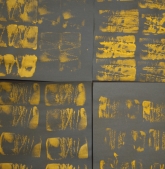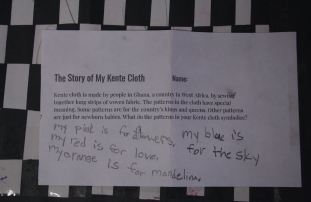After our unit in the caves, we flew off to a new country in West Africa; Ghana.
In first and second grade we looked at Kente cloth patterns
We started with making two patterned papers.

1. Printed gold patterns on black paper- we made printing blocks by wrapping twine around sponges
2. Painted geometric patterns using colour, line and shape
Once these papers were finished, we wove the two patterns together to create a new and intricate pattern. The black paper became our warp and the coloured was the weft strips. Weaving always goes over great- I did it with both groups last year, so this was review for most. We talked about how Kente cloth is used to make new clothes for special occasions and thought about what occasion we would make our designs for; a few students wrote artist statements about the meaning behind their finished pieces.

Third through fifth grade focused on the Adinkra symbols found on Kente cloth
We looked at examples of symbols and their meanings; and watched an artist through the process of stamping a design on cloth.
I gave the students sheets of ideas of existing symbols and encouraged to make a design of their own. They glued foam shapes onto a cardboard base.
The printing of these designs was exciting! Even after printmaking with classes this long, I still strive to make the process run more smoothly. I set up a long table in the middle of the room for inking, and each student at the remaining four tables had a number. When it was their turn, students inked their stamps in the middle and then returned to their tables to print. I encouraged them to rotate the stamps to create variation in their design and also incorporate a second symbol.








